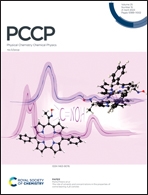Topology induced crossover between Langevin, subdiffusion, and Brownian diffusion regimes in supercooled water†
Abstract
Despite extensive studies of supercooled water, it remains challenging to understand its peculiar dynamic anomalous properties. In this work, we integrated full atomistic simulations of supercooled water over the temperature range of room temperature to 200 K using a quantum-mechanics-based polarizable force field with the dressed dynamics method that couples fast collision events and slow reorganization dynamics of hydrogen-bond networks. Our analysis unveils the salient multiscale features in the transient relaxation dynamics of supercooled water. A classical Langevin behavior dominates at fast timescales, while long-time relaxations unveil two different activation barriers in two temperature regions: below and above 230 K. The modulation of the entropy spectrum by temperature is elucidated in terms of a three-state model underlined by the complexity of the water dynamics associated with a topological transition of a strong hydrogen-bond network. This state-dependent network topology is quantitatively characterized by power-law exponents of inverse network connectivity from 200 to 298 K. This work provides valuable guidance for further studies on the transient relaxation dynamics of supercooled water.



 Please wait while we load your content...
Please wait while we load your content...